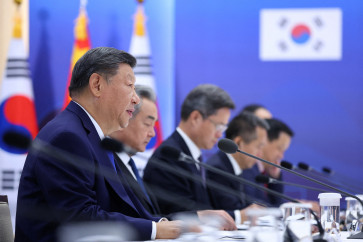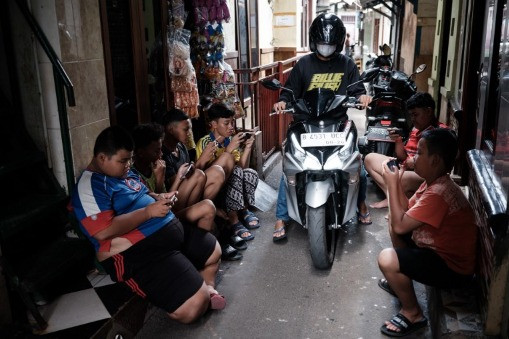Popular Reads
Top Results
Can't find what you're looking for?
View all search resultsPopular Reads
Top Results
Can't find what you're looking for?
View all search resultsThe military's show of force: What does it tell us?
On Sunday, June 1, 2014, the General Elections Commission (KPU) formally announced two legitimate pairs running for the presidency and vice presidency of Indonesia
Change text size
Gift Premium Articles
to Anyone
O
n Sunday, June 1, 2014, the General Elections Commission (KPU) formally announced two legitimate pairs running for the presidency and vice presidency of Indonesia. The public, both foreign and domestic, seems very excited to follow the country's political dynamics in the lead-up to the presidential election.
Amid the widespread fever of the start of the presidential race, another significant event took place in the country. From June 1 to 5, the Indonesian Military (TNI) held a major exercise involving nearly 14,000 troops, hundreds of armored vehicles and artillery pieces and dozens of warships and combat aircraft.
Other than a large-scale deployment of military forces, what is significant about the military drills?
First, the military exercise is a showcase of the TNI's professionalism. Despite some doubts and misgivings about its neutrality during the election, the military's high-command remains committed to keeping the officer corps away from civilian politics.
The increasing problems on Indonesia's borders and tensions in nearby regions further reinforce a perception within the military establishment about greater external threats to Indonesia, which have been the key driver of the TNI's recent focus on modernization and professionalism.
Second, although this was a regular exercise, the timing coincides with increased maritime tensions near Indonesia's borders. Recently, the Indonesian government was miffed by Malaysia's installation of a light beacon on Tanjung Datuk Island, which is located on the border between West Kalimantan and Sarawak. While filing a diplomatic protest against Kuala Lumpur, the Indonesian Navy stepped up its maritime presence in the disputed area.
Moreover, in early May this year, China placed an oil rig in waters claimed by Vietnam leading to renewed conflict in the South China Sea. Under the protection of approximately 80 Chinese navy and coast guard ships, the move suggests that Beijing was overtly making a 'strategic push' to assert its territorial claims in the disputed region.
To date, Indonesia is not a claimant in the multilateral disputes over the South China Sea. However, the country's defense establishment is aware that China's self-proclaimed nine-dashed line potentially overlaps with a segment of its exclusive economic zone (EEZ) adjacent to the Natuna Islands.
This perception is actually in line with the 2010 defense guideline that anticipates the islands and surrounding waters to be among Indonesia's flash-points. The possible conflict scenarios in this area include an external military presence and occupation of the country's EEZ.
Third, the military drills demonstrate doctrinal and operational innovations in the TNI. As a peace-loving country, Indonesia traditionally adopts an 'active defense' strategy to deal with and overcome external aggression. Under the existing defense doctrine, the Indonesian government avoids using military force at the initial stage of war, but swiftly launches offensive self-defense operations after the enemy's first strike.
On the battlefield, active defense stresses strategic defense capability to minimize the losses of national interests, while retaliating so as to exhaust the enemy's ability to sustain an aggression.
In past military exercises, the TNI drilled to halt an aggression before staging forceful counter-attacks and ultimately defeating the aggressor's strategic intention.
Given the changing strategic landscape and military technological developments, Indonesia's international position and diplomatic interests constantly evolve over time. In effect, the military's strategic thinking, force structure and deployment expand beyond the traditional perspective. Today, the TNI interprets active defense not only in terms of resisting and repelling a military aggression, but also as how to avert or deny the aggressor's war-making capability.
Under a scenario of imminent external aggression, the latest military exercise incorporates combat simulations for a 'multi-layered defense' strategy. Before conducting offensive self-defense operations and shore-based defense to repel the hostile forces out of Indonesia's borders, the drill includes preemptive assaults against the enemy in its own territory. In doing so, the TNI assigns its special forces for covert operations and information warfare aimed at dislocating the enemy's military strength or neutralizing its center of gravity.
As the Indonesian Military seeks to revitalize the country's active defense doctrine, it must also consider the strategic value of the concept from a deterrence perspective. Military deterrence essentially aims at defeating an enemy without fighting it on the battlefield.
For that purpose, the armed forces must acquire effective military capabilities and show a determination to use them. This way, it seeks to convince the enemy about the high cost of war and ultimately force it to accept peace terms.
In that sense, the TNI should further develop 'defensive deterrence' capability as part of Indonesia's active defense strategy. This means that the country's defense planning and deployment of military forces must focus on the overall defense of national interests ' including democracy and economic development, and acquisition of multi-dimensional strategic offense and defense capabilities. In this way, the TNI will be capable of achieving three strategic objectives of the country's active defense doctrine ' namely, persuading the enemy to delay or abandon military aggression, denying its ability to defeat us and defeating the hostile forces through decisive counterattacks.
The TNI's defensive deterrence power is by no means a secondary element to preserve Indonesia's national interests. If the country's deterrence credibility is compromised, many issues concerning national security ' including territorial integrity will be in danger. As Indonesia becomes more exposed to global and regional challenges, the application of active defense and defensive deterrence are as important as the country's democratic, economic and social resilience.
That said, the TNI's latest military drill is a strategic means to demonstrate Indonesia's defense capability for ensuring peace and stability in the region, while reassuring the public of its commitment to military professionalism.
The writer is a researcher at the Department of Politics and International Relations, Centre for Strategic and International Studies (CSIS), Jakarta. He is also an adjunct lecturer in the University of Indonesia's department of international relations.










